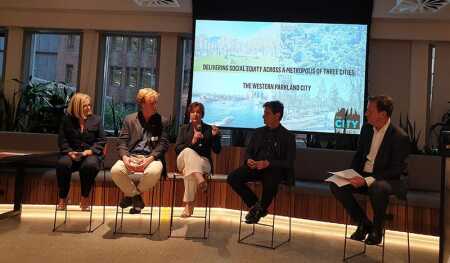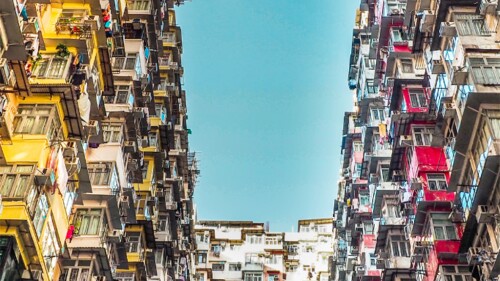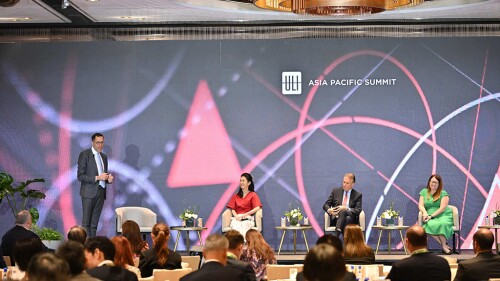
From left to right: Lucy Turnbull AO, Greater Sydney Commission chief commissioner; Ivan Harbour, architect and senior partner at Rogers Stirk Harbour + Partners; Margot Black, head of sustainability and community at Charter Hall; Carlos Frias, Urbis design director; and David McCracken, executive director of ULI Australia, speaking at an event in Sydney.
The Greater Sydney Commission (GSC) has prepared a 40-year vision for connecting and rebalancing growth and development in Greater Sydney, one of the fastest-growing regions in the developed world. The plan, A Metropolis of Three Cities, aligns land use, transport, and infrastructure planning to reshape the Greater Sydney region as three connected cities: Eastern Harbour City (Sydney’s traditional city core), Central River City (Parramatta, its long-time second central business district [CBD]) and Western Parkland City (a greenfield growth area anchored by Sydney’s soon-to-open second airport).
The aims of the plan are to sustainably manage the effects of population growth and to rectify current inequities across the metropolitan area. These will be achieved, firstly, through development of “30-minute cities” that enhance access through different modes of transport and provide diverse housing options, jobs, infrastructure, and services for more residents across the wider metropolitan area.
To rectify existing social equity imbalances, the Western Parkland and Central River cities will need to create more jobs, public transport choices, schools, and health and education facilities. A key challenge will be to address housing affordability, as Sydney is among the top five most expensive property markets in the world.
In the first of the three-part City Series event organized by ULI Australia and Urbis held last November, GSC chief commissioner Lucy Turnbull outlined how land use, transport, and infrastructure planning for the three connected areas have for the first time been prepared concurrently [see A Metropolis of Three Cities, Future Transport 2056 and the NSW State Infrastructure Strategy 2018–2038]. As a result, investment in infrastructure has been made in an integrated way so it is built where actually needed.
Stage 1 of the new Western Sydney Airport in Badgerys Creek is located 27 miles (43 km) west of the CBD. With operations expected to commence by 2026, the new facility is expected to be a catalyst for the creation of at least 200,000 new jobs. In order to create this “aerotropolis,” authorities are looking to streamline investment and planning approvals, boost local jobs numbers, and focus in particular on housing and livability to create a compact, walkable, diverse environment that is rich in activities.
According to Turnbull, the qualities we see in public spaces in the Sydney CBD such as “wide walkways, beautiful architecture, generous parks and open spaces” should also be present in Western Parkland City.
Carlos Frias, design director at Urbis, commented that “the pattern of development in existing settlements is quite dispersed and sprawled. How do we allow for high density in key areas early on? The existing cities will need to be connected not just with roads but with cycleways and efficient public transport.”
Ivan Harbours, meanwhile, architect and senior partner at Rogers Stirk Harbours + Partners, added that since Western Sydney Airport is so big, connectivity issues need to be addressed at the current planning stages. “There are some examples around the world of major airports segregating the areas they divide,” he said. “What are the logistics and design solutions that can address this? Will it be possible to cut travel time between Badgerys Creek and Sydney CBD from one to one and a half hours down to 10 minutes?”
In the end, the key indicator of success will be the aerotropolis’s ability to attract people to live, work, and raise a family there. Jobs alone will not be enough. Often, the social aspect of creating a city is treated as an afterthought, whereas it should really be considered front and center. Western Sydney therefore needs to focus on providing innovative housing solutions, social infrastructure, and interesting options for leisure, culture, and recreation.
To attract people and investment, the main driver will be the existing communities within the eight local government areas. The airport will only be secondary. Frias noted that success depends largely on governance and on engaging existing residents in the planning and development stages. “We will need to strike a good balance [between] planning and designing exciting new places, while protecting existing centers like Camden, Wollondilly, and Campbelltown, which have rich heritage.”
Margot Black, head of sustainability and community of property group Charter Hall, added that pockets of social exclusion and crime across these areas will also need to be addressed as a priority.
Harbours also emphasized that a challenge with new developments is that they may take several decades and property cycles for them to have an identifiable sense of place. This reinforces the need to get it right with existing communities and link them well with the aerotropolis.
KARMI PALAFOX, associate director at Urbis, is a strategic planner with expertise that encompasses planning, economics, urban design, and policy.
The next City Series event will focus on the Eastern Harbour City and will be part of the ULI Australia Summit March 24–27, 2020. ULI and Urbis are also launching the City Series in Melbourne and Brisbane this year.





